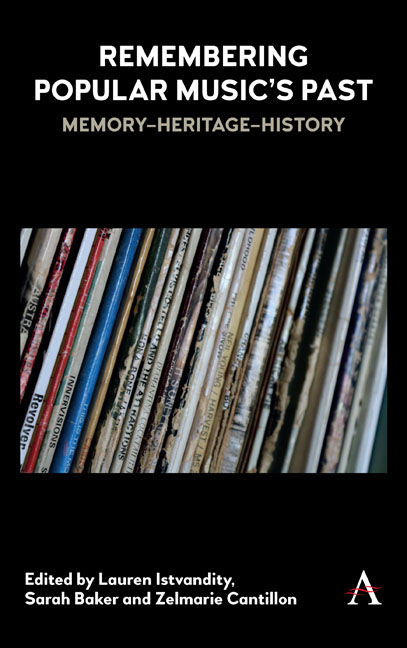Book contents
- Frontmatter
- Contents
- List of Figures
- Acknowledgements
- Chapter 1 The Precarity of Memory, Heritage and History in Remembering Popular Music's Past
- Part I MEMORY
- Part II HERITAGE
- Chapter 7 Mark II: Reworking the Heritage B(r)and
- Chapter 8 The Continually Precarious State of the Musical Object
- Chapter 9 Showing Off: Taking Popular Music Research into the Museum
- Chapter 10 Preserving Icelandic Popular Music Heritage: Issues of Collection, Access and Representation
- Chapter 11 Questioning the Future of Popular Music Heritage in the Age of Platform Capitalism
- Part III HISTORY
- List of Contributors
- Index
Chapter 8 - The Continually Precarious State of the Musical Object
from Part II - HERITAGE
Published online by Cambridge University Press: 09 July 2019
- Frontmatter
- Contents
- List of Figures
- Acknowledgements
- Chapter 1 The Precarity of Memory, Heritage and History in Remembering Popular Music's Past
- Part I MEMORY
- Part II HERITAGE
- Chapter 7 Mark II: Reworking the Heritage B(r)and
- Chapter 8 The Continually Precarious State of the Musical Object
- Chapter 9 Showing Off: Taking Popular Music Research into the Museum
- Chapter 10 Preserving Icelandic Popular Music Heritage: Issues of Collection, Access and Representation
- Chapter 11 Questioning the Future of Popular Music Heritage in the Age of Platform Capitalism
- Part III HISTORY
- List of Contributors
- Index
Summary
Introduction
Over the course of the past several years, I have visited a wide range of museums and exhibits about music and musicians. They have included displays chronicling popular and classical music traditions in Europe, the United Kingdom and the United States. Across nearly all of the exhibits I have studied, from the Bachhaus in Eisenach, Germany, to the Johnny Cash Museum in Nashville, United States, to The Beatles Story in Liverpool, England, I have found an extraordinary array of objects. In Eisenach, there was a shoe said to be very much like the sort J. S. Bach probably would have worn on one of his famous pilgrimages. In Liverpool, there was a guitar that quite possibly could have belonged to a young John Lennon. At A. P. Carter's Cabin in Hiltons, Virginia, an array of domestic appliances of the sort likely to have been used by members of the Carter Family dotted the interior of the recently relocated building. There were, of course, hundreds of authenticated objects as well, such as the cardigan Kurt Cobain wore for Nirvana's MTV Unplugged performance, a guitar Johnny Cash played on the American Recordings sessions, and Isaac Hayes's metallic blue Cadillac at the Stax Museum in Memphis. Regardless of their provenance, all of these objects were used as part of much larger tableaux intended to connect spectators to worlds that were long gone, whether it was Liverpool in the 1960s or Eisenach in the 1690s. The display practices intended to encompass a broad range of distinct musical histories and traditions all betray a few characteristic features of relevance here. They all take a range of both notable and utterly mundane objects and use them to implicate spectators in a pre-existing narrative particular to the music and musicians being exhibited. Also, those narratives are necessarily much larger than the exhibit or institution presenting them, and the mix of the remarkable and the ordinary is a crucial facet in recounting them. Further, as I have noted elsewhere, we are repeatedly told in exhibit after exhibit that the people whose lives are being retold in some fashion were both uniquely worthy of the attention paid to them and also very much like us in some fundamental respects (Fairchild 2018). It is the constant thrumming and productive tensions between these various formations that make such displays particularly meaningful.
- Type
- Chapter
- Information
- Remembering Popular Music's PastMemory-Heritage-History, pp. 101 - 114Publisher: Anthem PressPrint publication year: 2019



